![Leroy White, Wall of Respect, Up You Mighty Race, Leffingwell & Franklin Aves, St. Louis MO, 1968 [destroyed 1980s].jpg Leroy White, Wall of Respect, Up You Mighty Race, Leffingwell & Franklin Aves, St. Louis MO, 1968 [destroyed 1980s].jpg](https://486312.frmmmguz.asia/files/square_thumbnails/ccbe25581b885dd6ea7ad25405af90fe.jpg)
Wall of Respect/Up You Mighty Race
In 1968, after the success of Chicago’s Wall of Respect in 1967, muralist Leroy White painted Wall of Respect/Up You Mighty Race in St. Louis, Missouri. The mural was self-sponsored. After seeing Chicago’s Wall of Respect in Ebony, muralists in St. Louis were inspired to create public art in the Carr Square area of the city. The mural was completed by a coalition of individuals from civil rights groups, including CORE, ACTION, and the Zulu 1200s. It displayed a pantheon of black heroes, including the antislavery leaders Frederick Douglass, Malcolm X, Martin Luther King Jr., and Marcus Garvey. The mural quickly became a hub of black activism—bringing together artists, performers and political figures in a series of concerts and rallies at the site. But it was vandalised during the 1970s, and its building was razed in the 1980s.
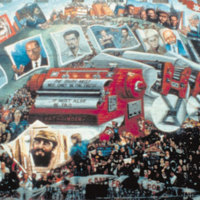
Pathfinder Mural
In 1988, Mike Alewitz designed and began to direct the creation of Pathfinder Mural in New York City’s West Village. The mural, measuring 79 x 85 feet, was an international collaboration of 80 artists from 20 different countries including Argentina, Canada, Iran, New Zealand, Nicaragua and South Africa. At its dedication, it was hailed as one of the largest political murals in the world. In 1987, Alewitz had approached the leaders of the Socialist Workers Party (SWP), of which he was a member, and proposed that Pathfinder Press sponsored a mural for its Charles Street building. The party approved both the project and his concept of the mural: a celebration of the revolutionary struggles in Cuba, Grenada, Nicaragua and South Africa, as well as in America. The central image of the mural is a large red printing press. The faces of Fidel Castro, Che Guevara, Malcolm X, Karl Marx, and Nelson Mandela loop around it. The abolitionists Frederick Douglass, Harriet Tubman and Sojourner Truth also feature. During the creation of Pathfinder Mural, the National Endowment for the Arts withdrew funding from several controversial projects, prompting a debate on free speech and censorship. For the first few months of this mural's creation, work continued without incident. But in 1989, Patrick Buchanan, a conservative commentator, vilified the mural in the Washington Times, calling it a “six-story shrine to communism, a Marxist Mount Rushmore in Greenwich Village." As the mural neared completion, the dialogue between Alewitz and the SWP started to break down. Alewitz was blocked from attending the mural dedication ceremony on November 19, 1989. During December, vandals threw glass bottles filled with white paint at the mural. In 1996, the mural was removed in order to repair cracks in exterior wall of the Pathfinder building, and by 2003, the building on which Pathfinder Mural was housed was sold for around $20 million.
![Wardell McClain, Sim's Corner Wall of Respect, 618 E 47th St at South Champlain Ave. [Black Neighborhood], Chicago, 2009.jpg Wardell McClain, Sim's Corner Wall of Respect, 618 E 47th St at South Champlain Ave. [Black Neighborhood], Chicago, 2009.jpg](https://486312.frmmmguz.asia/files/square_thumbnails/1018bd0dce61a7264d61cd9907fc7cfe.jpg)
Sim's Corner Wall of Respect
In 2009, Wardell McClain created a mural on South Champlain Avenue in Chicago, Illinois titled Sim's Corner Wall of Respect, that took its inspiration from the 1967 mural, Wall of Respect. It includes the faces of the abolitonists Frederick Douglass, Harriet Tubman, and Sojourner Truth as well as Martin Luther King Jr., Jesse Jackson, Malcolm X, Harold Washington, Elijah Muhammad, Nelson Mandela, Michael Jordan, Coretta Scott King, Marcus Garvey and Booker T. Washington.
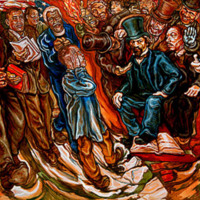
Wall of Black Heroes
In 2006, muralist Joseph Tiberino, along with his sons Gabe and Raphael, painted Wall of Black Heroes for the African American Museum of Philadelphia. When creating the mural, the idea was to provide a portable piece of work that would later be housed in the streets. Measuring 4ft by 12ft, the mural was created on such a scale so as to provide the audience with the sense that the figures of history were life-size. The mural takes the audience on a historical journey, starting with a self-emancipating shackled slave, then moving to the abolitionists Frederick Douglass andHarriet Tubman, then Angela Davis and Malcolm X, Spike Lee, Paul Robeson, Louis Armstrong and Martin Luther King Jr. The mural is now on the side of the Municipal Services Building next to City Hall.
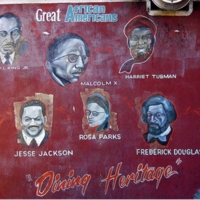
Great African Americans
An unknown artist painted this mural in Harlem, New York City, on the facade of Dining Heritage. It depicts the abolitionists Frederick Douglass and Harriet Tubman, as well as Martin Luther King Jr., Rosa Parks, Jesse Jackson and Malcolm X. It was destroyed in 2015.
![Don Rodgers, Our Brothers and Sisters, 100th and Halsted Streets [Black Neighborhood], Chicago, 1984.jpg Don Rodgers, Our Brothers and Sisters, 100th and Halsted Streets [Black Neighborhood], Chicago, 1984.jpg](https://486312.frmmmguz.asia/files/square_thumbnails/ade8cb4554aca77fae33825bf55434dc.jpg)
Our Brothers and Sisters
Titled Our Brothers and Sisters, this mural depicts figures of black history, including the abolitionist Frederick Douglass and also Harold Washington, Martin Luther King Jr., Booker T. Washington, Malcolm X, W.E.B. Du Bois, and Louis Armstrong.
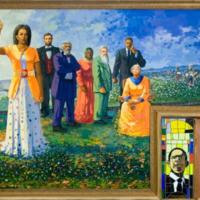
From Menelik I to Obama
Ethiopian artist Mekbib Gebertsadik put the abolitionist Frederick Douglass alongside President Lincoln, the abolitionist John Brown, Malcolm X, President Obama and Michelle Obama. Titling the mural From Menelik I to Obama, Gebertsadik also placeed Douglass on a timeline of diasporic history that starts with Menelik I, the first Solomonic Emperor of Ethiopia in 950 BC, to President Barack Obama, the first African American president. The mural is a few blocks away from the White House at the Gospel Rescue Ministries homeless shelter, acting as a symbol of hope for those passing through. “Primarily, the clients we serve are African American and [the mural is] an inspiration to our clients of being able to dream” explains Earl Murray, Associate Director for Development and Marketing for Gospel Rescue Ministries.
![Eugene 'Edaw' Wade, Cramton Auditorium Mural, Howard University, 1976 [destroyed].jpg Eugene 'Edaw' Wade, Cramton Auditorium Mural, Howard University, 1976 [destroyed].jpg](https://486312.frmmmguz.asia/files/square_thumbnails/9b88d25ab0cf2bbdaa447fb07c56eee8.jpg)
Cramton Auditorium Mural
In 1976, Eugene Eda Wade created a mural at Howard University in Washington D.C. The mural depicts the abolitionists Sojourner Truth and Nathaniel Turner attempting to break chains, as well as the abolitionists Frederick Douglass and Harriet Tubman, and leaders Malcolm X and Martin Luther King Jr. The mural has now been destroyed.
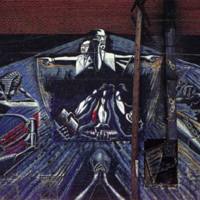
Wall of Meditation
In 1970, Eugene Eda Wade painted the Wall of Meditation on the exterior façade of the Olivet Community Center. Malcolm X and Martin Luther King Jr. anchor the middle of the mural, and are surrounded by Egyptian figures on the left, and enslaved figures breaking free from their chains on the right.
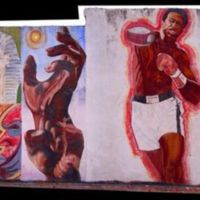
Wall of Respect
Borrowing its name from the 1967 “Wall of Respect” of Chiacgo, muralists Ashanti Johnson, Nathan Hoskins and Verna Parks installed their own public artwork in Atlanta. The abolitionist Frederick Douglass is alongside Martin Luther King Jr., Malcolm X and W.E.B. Du Bois, with the North Star between them. Angela Davis and Muhammad Ali are also present. The mural was destroyed in 2007.
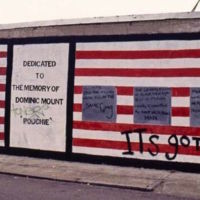
All in the Same Gang
In 1998, at the height of gang related murders in the city of Boston, Jameel Parker was commissioned to paint a mural by Gang Peace, a not-for-profit, street-based programme seeking to reduce the number of murders in Boston by redirecting youths into education and career-oriented activities. In 1992, around 600 local youths between the ages of 8 and 23 participated in Gang Peace programmes. Parker’s mural, titled All in the Same Gang, was painted in Boston and became a monument to those who had died as a result of gang crime. During its creation, on the corner of the street where the mural was painted – Blue Hill Avenue and Floyd Street – a young boy named Dominic Mount was murdered. Given the immediate community outcry following his death, Parker dedicated the mural to Mount and placed his name alongside heroes of Black history; Frederick Douglass, W.E.B. Du Bois, Malcolm X and Elijah Muhammad. By 2016, the portraits of the African American male leaders had faded and the mural had changed to now include four black women, includng abolitionist Harriet Tubman.